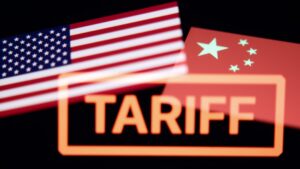China’s New Tariffs: What Investors Need to Know
In a significant move signaling the ongoing trade tensions between two global economic powerhouses, China has announced a series of new tariffs on U.S. imports that could have far-reaching implications for investors. This decision, which comes on the heels of additional tariffs imposed by the U.S. on Chinese goods, highlights a complex and evolving trade landscape that every savvy investor should monitor closely.
What are the New Tariffs?
On February 10, China’s finance ministry will implement a 15% tariff on coal and liquified natural gas imports from the United States. Additionally, there will be a 10% increase in duties on American crude oil, agricultural equipment, and certain car models. This latest announcement was made just minutes after the U.S. introduced blanket 10% tariffs on a range of Chinese goods, underscoring a tit-for-tat approach in what has become an ongoing trade conflict.
China’s officials articulated concerns that the U.S. actions "seriously violate the rules of the World Trade Organization" (WTO), suggesting that this situation could lead to further escalations in the conflict.
Moreover, China’s commerce ministry is set to impose export controls on several critical minerals, including tungsten, tellurium, and ruthenium. These minerals are crucial for various industries, including technology and renewable energy, indicating that the repercussions of these tariffs could extend beyond immediate trade impacts to influence global supply chains.
Implications for U.S.-China Relations
While U.S. President Donald Trump recently agreed to a 30-day delay on planned tariffs on imports from Canada and Mexico—tied to measures against illicit fentanyl trafficking—his administration remains focused on Chinese compliance with trade agreements. The situation is complex: the world is witnessing an intricate play of diplomacy and economic strategy where both nations are seeking to assert their standings on the global stage.
As Trump begins his second term, an assessment of trade deal compliance with China from his first term is due by April 1. This evaluation could result in further tariff developments, which has the potential to complicate market conditions for industries heavily reliant on international trade, not to mention the immediate impacts on stock valuations linked to affected sectors.
What Should Investors Do?
-
Diversification is Key: As trade tensions escalate, sectors such as energy, agriculture, and manufacturing might experience volatility. Investors should consider diversifying their portfolios to mitigate risks associated with overexposure to any single market or sector.
-
Monitor Global Supply Chains: Companies relying on critical minerals or energy imports from China should keep a close eye on potential supply chain disruptions. Understanding these dynamics could provide insight into future market movements and company profitability.
-
Stay Informed: Economic policies can change rapidly. Regularly updating your knowledge base about trade agreements and tariff developments is crucial. Subscribing to economic analysis newsletters like our own Extreme Investor Network can keep you ahead of the curve.
-
Evaluate Company Exposure: For investors in publicly traded companies, assessing how exposed those firms are to tariffs and trade disputes is vital. Companies with significant international operations or those reliant on exports to China may face profit margin compressions that could affect stock performance.
- Consider the Bigger Picture: Tariffs are not just about trade; they can indicate larger geopolitical struggles. Understanding the underlying economic and political motivations can give investors a strategic advantage.
Conclusion
The ongoing tug-of-war between the U.S. and China over tariffs is both a symptom of and a catalyst for larger economic trends. As the situation develops, investors must be proactive. With timely information and strategic planning, members of the Extreme Investor Network can navigate these turbulent waters and position themselves for success. Stay informed—because in the world of investing, knowledge is power.

